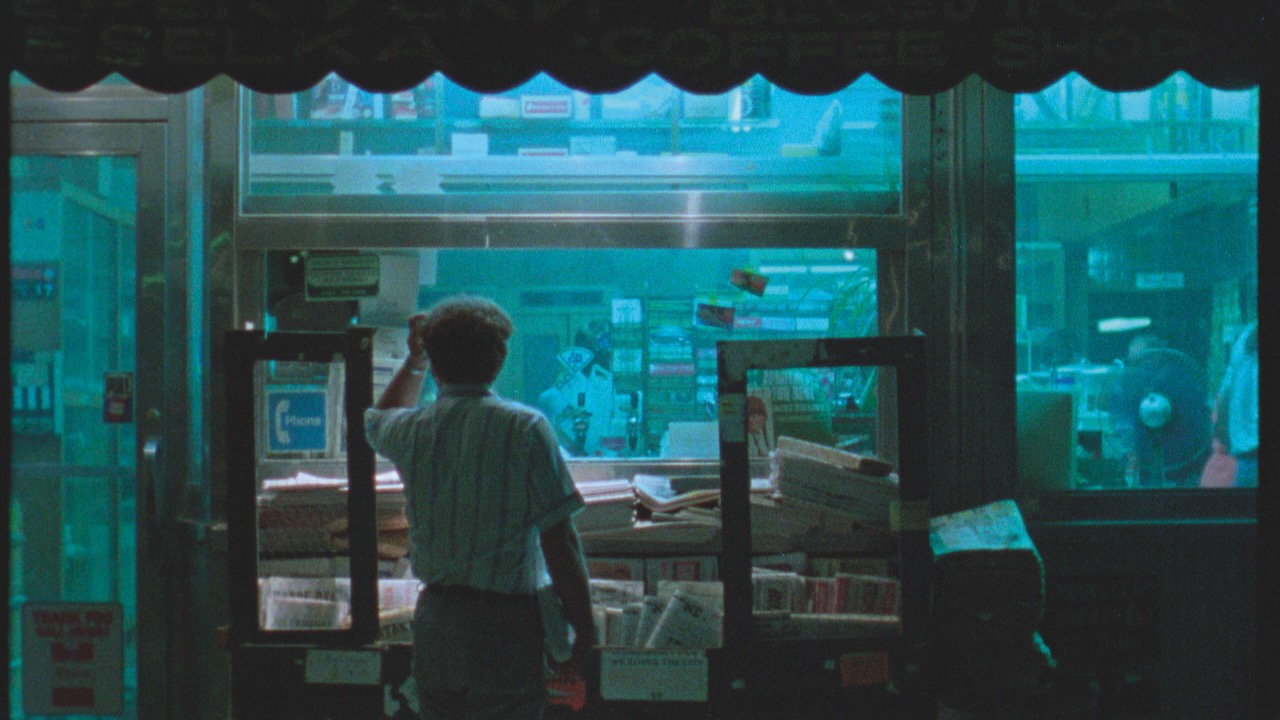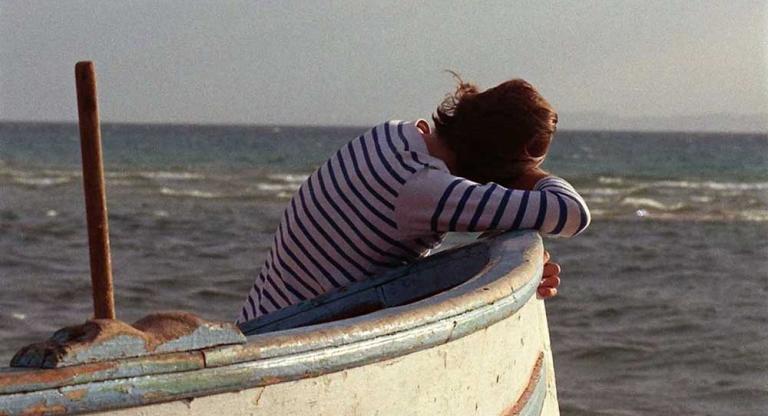“I love it. Still not free from my mother.”
-Chantal Akerman on News From Home (1977), from an interview with the French film theorist Nicole Brenez.
The film opens in desolate Tribeca with a low-angle shot, the camera pointed toward a barren and beautiful two-block stretch of Staple Street, with its unique green cast-iron skybridge connecting two 19th-century brick buildings. A large car turns onto the street, drives slowly toward and past the camera. In the distant background, as if on cue, three kids appear, carrying hefty boxes. The action within this perfectly composed tableau, with dusky colors worthy of a Hopper painting, somehow feels at once carefully choreographed and completely random. Cut to a view of another empty street in what looks like the Meatpacking district. A truck and VW Beetle quietly pass by, and the Hudson river is seen in the background. After a few minutes of these contemplative shots, we hear the filmmaker’s voice, reading: “Dear Child. I received your letter and hope you will write often. I hope you won’t stay away and that you’ve found a job by now.”
News From Home, the first film Akerman made after Jeanne Dielman, 23 Commerce du Quay, 1080 Bruxelles (1975), marked the suddenly prominent young filmmaker’s return to New York City, where she had lived from 1971 to 1973, finding her artistic voice by moving a continent away from her native Brussels and immersing herself in the city’s experimental art scene. A cinematic bildungsroman, News From Home is built on a fascinating tension between the intimate and the impersonal. Its only spoken words are Akerman’s recital of the many letters she received from home during those early pre-Dielman years, filled with the mundane details of daily life and overprotective concern from “your loving mother who thinks about you often.” The imagery, in which Akerman herself is only glimpsed for a few seconds in the reflection of a subway car window, is an alien’s view of the city, which is wondrously defamiliarized in just over 50 exquisitely composed shots–long, static takes from a fixed position, or steady traveling shots from a car, as Akerman traverses the city’s periphery and its underground. The most memorable images, by cinematographer Babette Mangolte (who also shot Jeanne Dielman and was Akerman’s friend and mentor in her early New York days) are its painterly studies of subway platforms along Seventh Avenue. (According to Mangolte, News From Home was commissioned for German television. They filmed it in seven days, and used much of the production money to pay off debts from Jeanne Dielman. Mangolte photographed the movie with no idea that Akerman would use her mother’s letters on the soundtrack.)
There is an uncanny quality to the film’s view of an eerily depopulated city in the “Ford to New York: Drop Dead” years. We are constantly trying to orient ourselves as we watch, but this is an exile’s view, the city seen with fascination, but from a distance, somehow feeling like a ghost town. Fittingly (and now eerily), the most prominent major landmark in the film is the World Trade Center, its newly opened Twin Towers emerging in a foggy skyline from the rear of the Staten Island Ferry during the nearly 10-minute shot that makes up its finale.
News From Home is the clearest expression of Akerman’s intense attachment to her mother, Natalia. This attachment was present throughout her entire filmography, from a 1967 short film submitted with her film school application that shows Natalia shopping for shoes, to her final film, No Home Movie (2015), which was built around a series of in-person and Skype conversations between mother and daughter. Natalia’s presence was felt, either as herself or through surrogate characters, in many of Akerman’s films. In Les Rendez-vous D’Anna (1978) an itinerant film director, played by Aurore Clement, lies in bed with her mother during a visit and confesses a lesbian affair, adding that she thought about her mother while having sex. In News From Home, we hear Natalia complain in a mother’s guilt-inducing way of not hearing from Chantal. “Dearest, I got your last letter ten days ago. I’m wondering what happened. I sent you twenty dollars. Let us hear from you soon.” Natalia wonders what has become of her daughter. In a way, the film we are watching is Akerman’s response to the letters: the answer to what she has been doing, finding her identity by engaging with the world and learning to see it in a unique, mysterious way.
A precious time capsule of a pre-Starbucks metropolis, News From Home (which ranked #52 on the recent Sight and Sound poll, behind Jeanne Dielman at #1) is a cinematic journey that reveals new wonders on each viewing, especially in the Royal Film Archive of Belgium’s exquisite restoration.
News From Home screens this evening, October 16, at the Museum of Modern Art as part of the series “Chantal Akerman: The Long View.”



